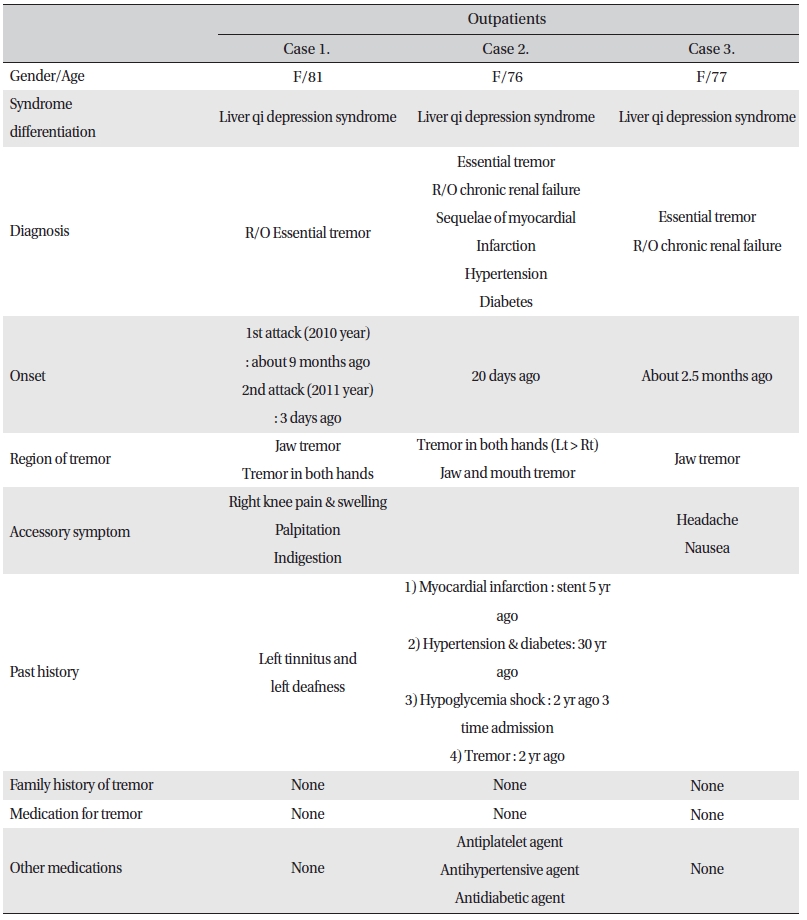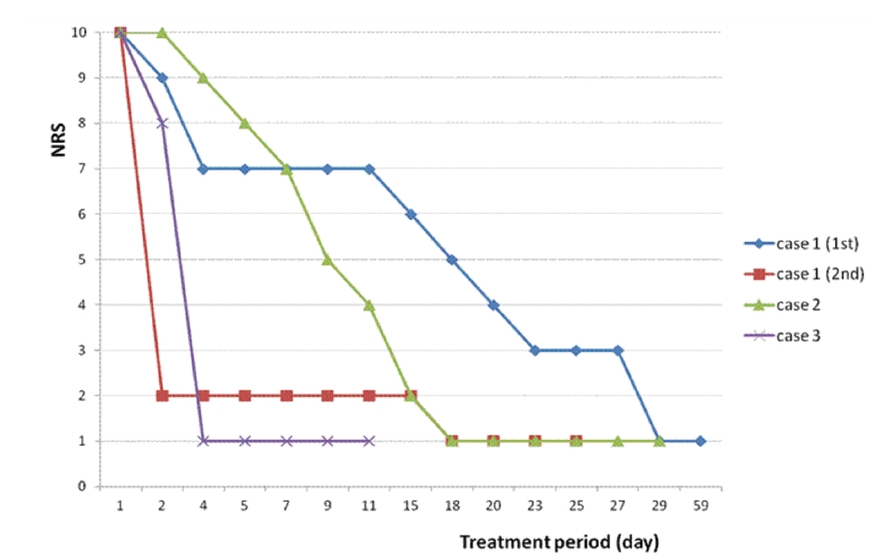



The purpose of this study was to report the effect of a combination of Sa-am five-element acupuncture and eight-principle pharmacopuncture (EPP) for the treatment of an essential tremor (ET). This study reviewed the medical records treated at OO Korean medical hospital for ET by using diverse types of acupuncture without herbal medicine, other types of physical therapy, and western medication related ET or Parkinson’s disease and was performed after the approval of the institutional review board (IRB). The three cases that were finally selected were then extracted and reviewed. The three cases that were finally selected involved three women in their 70s to 80s. The evaluation of the progress was made by using the numeric rating scale. A combined treatment, the method of liver excess (肝乘格), from among Sa-am five-element acupuncture, and Hwangyeonhaedoktang EPP at CV23 and CV17, was applied to all cases. In all three cases, the ET was improved, and recurred ETs improved with the same treatment. The results suggest that the combined treatment of Sa-am five-element acupuncture and Hwangyeonhaedoktang EPP may be effective for treating an ET, even though this conclusion is based on only three cases.
Essential tremor (ET) is one of the most common kinetic disorders, and inversely depends on age. An ET is a kinetic tremor that commonly occurs in the arms during voluntary movements such as pouring, drinking, eating, writing, and other daily activities, but especially occurs in the head, neck, and voice, and occasionally in the tongue, trunk, legs and so on [1, 2].
The prevalence of ET varied from 0.008% to 22% [1], but the range of prevalence estimates with other specified method was 0.4%-3.9% [1]. A population-based study in Turkey reported that the prevalence of ET was 4.0% among individuals age 40 yr or older [3].
ET has been treated with diverse methods such as propranolol, primidone, topiramate, clozapine, Botulinum toxin type A, thalamic deep-brain stimulation (DBS), subthalamic nucleus DBS, and so on [4].
Pharmacopuncture is a new form of acupuncture combining acupuncture that has been promoted in Korea and is based on the meridian theory and a natural herbal medicine based on qi and flavor theory [7, 8].
Several studies on
We had the medical record officer select the medical records of patients have treated for an ET by using diverse types of acupuncture without herbal medicine or by using other physical therapies at Sangji University Korean Medicine Hospital from March 2006 to December 2011, from which the three cases reported here were selected. The medical records included data such as gender, age, diagnosis, past history, family history, current medical history, intervention, information on symptom improvement (scale or progress, etc.), other related information (laboratory tests, imaging, etc.), and Western medication. The medical records that included a history of herbal medication, anti-ET drug, such as proranolol, primidone, etc., use, anti- parkinsonian drug, such as levodopa, catechol-O-methyl transferase inhibitors, monoamine oxidase inhibitors, bromocriptine, anti-cholinergics, amantidine, use, and so on were excluded.
Three outpatients were finally selected after the secondary data had been reviewed to eliminate individual information. This study was performed with the approval of institutional review board (No: SJ IRB 120229) for a retrospective review of medical records.
The three cases that were finally selected involved women in their 70s to 80s who had been treated using acupuncture and pharmacopuncture, namely, standard methods of treatment for ET in our hospital. The details are as follows:
2.2.1. Treatment
For acupuncture treatment, 0.25 mm × 3.0 mm sterilized stainless-steel needles (
2.2.2. Evaluation
The method to evaluate the progress was the numeric rating scale (NRS) in all cases. The NRS was an 11?point horizontal scale ranging from 0 to 10 (NRS 10 for the most severe conditions of ET on first visit; NRS 0 for no symptoms of ET) [12].
2.2.3. Results of Cases [Table.
Case 1 was an 81-yr-old woman complaining of symptoms such as jaw tremor, tremors in both hands upon action, pain and swelling in the right knee and the right ankle, heart palpitations, red tongue, and tight and rapid pulse, which had started about 9 months earlier. She had been under great stress since the death of her son. The neurological examination at our hospital and the brain computed tomography (brain CT) scan and other examinations at another hospital showed no abnormal findings. She had no past history of tremors and no history of medication, but had had left tinnitus and deafness before the onset of the ET symptoms.
The severity of tremors was decreased 30% on the 4th day after treatment, 70% on the 23th day after treatment, 90% on the 29th day after treatment. After that, slight tremors occurred under stress intermittently. The treatment was terminated because the symptom remained for about one month. The tremor occurred again the next year (Case I-2nd), but the symptom was decreased 90% after treatments. The treatment was finished without worsening of tremors. No improvements in knee pain, tinnitus, and deafness, in spite of two periods of treatment, were noted.
Case 2 was a 76-yr-old woman complaining of the tremor in both her hands and in her jaw and mouth on action, red tongue without fur, tight and rapid pulse, and tenderness in CV17, which had started 20 days earlier. She had the past history of myocardial infarction, hypertension, diabetes mellitus, hypoglycemia shock and ET. She had taken anti-platelet, antihypertensive, and anti-diabetic medications. The brain CT was normal, but the laboratory test showed blood urea nitrogen (BUN) 48 mg/dL, creatinine 3.6 (0.6-1.4) mg/dL, red blood cells 2.43 (3.5-5.5) ×106 uL, hemoglobin 7.5 (11.5-17) g/dL, which implied renal failure. Korean medical treatment two yr earlier had improved the ET. The NRS score was decreased continuously during the 18 days of treatment.
Case 3 was a 77-yr-old woman complaining of jaw tremor, headache, and nausea. A mild jaw tremor had occurred intermittently during the previous 7 months, but had worsened during the last 2.5 months. She was diagnosed with chronic renal failure based on the laboratory test and the normal finding on the brain CT scan at another hospital. We diagnosed her as having an ET based on the jaw tremor with no hand tremor and on the normal neurological examination and brain CT. The symptoms showed good improvement (from NRS 10 to NRS 1) after 3 treatments, despite the long duration of the ET.
[Table. 1] Characteristics of the three cases

Characteristics of the three cases
This method of
HHP, among EPP, was extracted by collecting distilled water from boiling
All three cases were improved, and a recurred ET was also improved by using the same treatment. Case 1-2nd and case 3 showed dramatic improvements after at 2 to 3 treatments. In accordance with a previous similar study [19], the shorter the morbid duration is, the shorter the treatment time is based on the results of case 1 and case 2. We suggest that this result will provide basic data on Korean medicine treatment for an ET and that this combined treatment can be applied to patients to whom drugs cannot be administered because they suffer from diseases such as renal failure, even though this conclusion is based on only three cases.
This study has limitations in that the results of three case reports cannot be generalized because of loss of control and an insufficient number of subjects and because which treatment, acupuncture or pharmacopuncture, might have been more effective, if either, could not be identified. Nevertheless, the results suggest that combined treatment of


